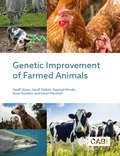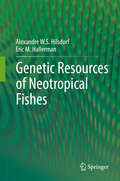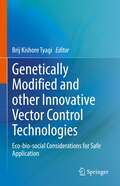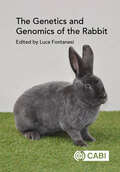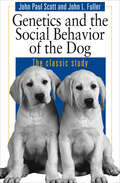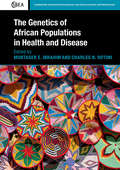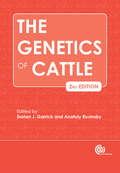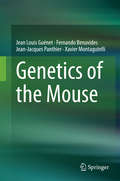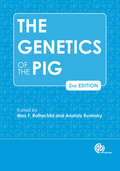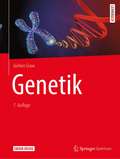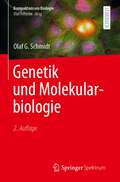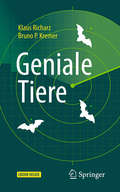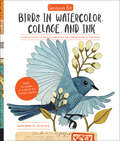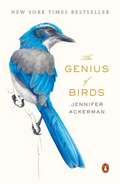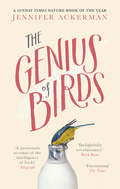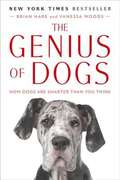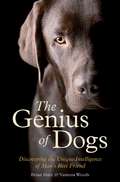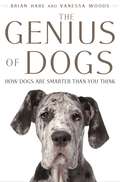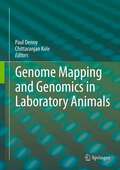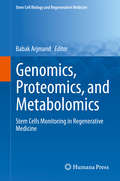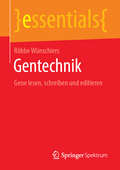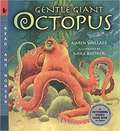- Table View
- List View
Genetic Improvement of Farmed Animals
by Geoff Simm Dr Geoff Pollott Raphael A Mrode Professor Ross Houston Dr Karen MarshallGenetic Improvement of Farmed Animals provides a thorough grounding in the basic sciences underpinning farmed animal breeding. Relating science to practical application, it covers all the major farmed animal species: cattle, sheep, goats, poultry, pigs and aquaculture species. The book: - Provides comprehensive coverage - from fundamental genetics, analysis of variation, prediction of breeding values and response to selection, through to application of modern genomics and biotechnology. - Illustrates the practical application of theory in temperate and tropical systems. - Outlines current practice and explores future directions, including sustainability and ethical implications, to leave readers completely up to date. Based on the previous bestseller, Genetic Improvement of Cattle and Sheep, this book has been completely revised, expanded and redesigned to be an essential textbook for undergraduate, masters and other early postgraduate-level students in agriculture, animal and veterinary science, as well as breeders, farmers, industry technical staff, advisors and extension workers.
Genetic Resources of Neotropical Fishes
by Alexandre W. S. Hilsdorf Eric M. HallermanThe aim of this book is to systematize and discuss population genetic studies of freshwater fish in a region that harbors the greatest diversity of species among all inland water ecosystems. This volume explores the genetic evaluation for a number of orders, families and species of Neotropical fishes, and provides an overview on genetic resources and diversity and their relationships with fish domestication, breeding, and food production.
Genetically Modified and other Innovative Vector Control Technologies: Eco-bio-social Considerations for Safe Application
by Brij Kishore TyagiThis book comprehensively covers the latest development in developing and deploying the genetically modified vectors, particularly Anopheles and Aedes mosquitoes responsible for transmitting malaria parasites and dengue viruses, the most deadly and/or debilitating among all the vector-borne diseases. It is considered timely and commensurate to bring about a book dealing with the various ecological, biological and social as well as regulatory aspects for the deployment of genetically modified vectors in special context with the biosafety of humans, his associates, and the environment. Written by an array of specialists and experts in various subjects of genetically modified organisms, this book centrally addresses the (i) basic principles of the genetic manipulation of vectors and they are potential impact on human and the environment, (ii) ecological, biological, ethical, legal and social implications of the use of genetically modified vectors, (iii) identification of potential hazards; assessment and management of risks for human and environment; risk/benefit analysis, (iv) principles and practices for the assessment and management of biosecurity and biosafety in laboratories (and in the field), (v) guiding principles for creation and management of institutional or national biosafety review boards and ethics review committees, and (vi) development and application of a biosafety regulatory framework and its related legal principles at national levels for securing the development and use of vector control methods based on genetic modification strategies. This publication will be useful to researchers, scientists, and professionals engaged in academic and research institutions, government or non-government, as well as students in universities and medical colleges.
The Genetics and Genomics of the Rabbit
by Domenico Spina Cristiano Boiti Bernd Fischer Jianglin Fan Zsuzsanna Bosze Joana Abrantes Marielle Afanassieff Daniel Allain Andre Almeida Susana S. Araújo Manuel Baselga Agustin Blasco Paul Boettcher Gerard Bolet Darko Bosnakovski Samuel Boucher Samuele Bovo Gudrun A. Brockmann Luca Buttazzoni Cesare Castellini Pascale Chavatte-Palmer Peter Chrenek Veronique Duranthon Pedro José Esteves María-Luz García Hervé Garreau Elen Gócza Mélanie Gunia Pilar Hernández László Hiripi Arata Honda Adriana Kolesárová Ana Lemos de Matos Rose Mage Manolis Matzapetakis István Nagy Clive Page Mariana Palma Miriam Piles Andrea Rau Andreas Ritsch Claire Rogel-Gaillard Jun Pablo Sanchez Maria Antonia Santacreu Pierre Savatier Giuseppina Schiavo Ina Sternstein Zsolt Szendro Valerio Joe UtzeriRabbits have many uses - as well as being cherished pets, they are bred for their meat and fur, and as laboratory animals. Understanding their genetics and genomics is key to their production and, equally, to their care, welfare and health. Beginning with an introduction to the rabbit, including key information on their evolution, domestication and breed types, this book then concentrates on the genetics and genomics of this valuable animal. This book covers: - Cytogenetics, genetic maps and QTL mapping; - Immunogenetics; - Genetics of coat colour, meat, fibre and fur production, reproduction, disease resistance and more. Concluding with practical applications such as creating transgenic and genome edited rabbits, biotechnical applications and the rabbit as a biomedical model, this book brings this important topic fully up-to-date. It provides an indispensable resource for animal and veterinary researchers and students, as well as rabbit breeders and laboratory scientists.
Genetics and the Social Behavior of the Dog
by John Paul Scott John L. FullerThe classic study of dog behavior gathered into one volume. Based on twenty years of research at the Jackson Laboratory, this is the single most important and comprehensive reference work on the behavior of dogs ever complied. "Genetics and the Social Behavior of the Dog is one of the most important texts on canine behavior published to date. Anyone interested in breeding, training, or canine behavior must own this book."--Wayne Hunthausen, D.V.M., Director of Animal Behavior Consultations "This pioneering research on dog behavioral genetics is a timeless classic for all serious students of ethology and canine behavior."--Dr. Michael Fox, Senior Advisor to the President, The Humane Society of the United States "A major authoritative work. . . . Immensely rewarding reading for anyone concerned with dog-breeding."--Times Literary Supplement "The last comprehensive study [of dog behavior] was concluded more than thirty years ago, when John Paul Scott and John L. Fuller published their seminal work Genetics and the Social Behavior of the Dog."--Mark Derr, The Atlantic Monthly "Genetics and the Social Behavior of the Dog is essential reading for anyone involved in the breeding of dogs. No breeder can afford to ignore the principles of proper socialization first discovered and articulated in this landmark study."-The Monks of New Skete, authors of How to Be Your Dog's Best Friend and the video series Raising Your Dog with the Monks of New Skete.
The Genetics of African Populations in Health and Disease (Cambridge Studies in Biological and Evolutionary Anthropology #84)
by Muntaser E. Ibrahim Charles N. RotimiThe birthplace of modern humans, Africa, has the highest genetic diversity in the world, yet it remains vastly understudied. With biomedical research increasingly focused on human variation, studying the large population size and number of mutations in African genomes could unravel the complexity of phenotypic traits underlying the biology of our species and hold huge potential for scientific and medical advances. An initial chapter 'conceptualizes Africa', providing relevant terminology. The first section covers genetic history and population structure. The next section looks at the genetic basis of common infectious diseases, such as leishmaniasis, malaria and tuberculosis, with a final part considering common non-communicable diseases, such as diabetes, hypertension, obesity, heart disease and cancer. Gene environment interaction under globalization and the burden of diseases of lifestyle are included. For researchers and graduate students in biological anthropology, genetic anthropology, human and population genetics, and public health.
The Genetics of Cattle 2nd edition
by Anatoly Ruvinsky Dorian GarrickSince the time of domestication more than 10,000 years ago, cattle have played an increasingly crucial role in the development of human civilizations. Progress has been quite remarkable since the turn of the century; the sequencing of the bovine genome in 2009 launched new avenues for furthering our understanding of theoretical and practical aspects of cattle genetics. Covering a vast array of questions, this book reviews major topics from molecular and developmental genetics, disease resistance and immunogenetics to genetic improvement of dairy and beef breeds, addressing all current problems in the field. This second edition includes a new team of authors and completely new chapters on the genetics of fat production, nutrition, feed intake and efficiency, growth and body composition. Fully updated throughout, it provides a valuable resource on cattle genetics for researchers, breeders, veterinarians and postgraduate students.
Genetics of Cattle, The
by Dorian J. Garrick Anatoly RuvinskySince the time of domestication more than 10,000 years ago, cattle have played an increasingly crucial role in the development of human civilizations. Progress has been quite remarkable since the turn of the century; the sequencing of the bovine genome in 2009 launched new avenues for furthering our understanding of theoretical and practical aspects of cattle genetics. Covering a vast array of questions, this book reviews major topics from molecular and developmental genetics, disease resistance and immunogenetics to genetic improvement of dairy and beef breeds, addressing all current problems in the field. This second edition includes a new team of authors and completely new chapters on the genetics of fat production, nutrition, feed intake and efficiency, growth and body composition. Fully updated throughout, it provides a valuable resource on cattle genetics for researchers, breeders, veterinarians and postgraduate students.
Genetics of the Mouse
by Jean Louis Guénet Fernando Benavides Jean-Jacques Panthier Xavier MontagutelliThis book, written by experienced geneticists, covers topics ranging from the natural history of the mouse species, its handling and reproduction in the laboratory, and its classical genetics and cytogenetics, to modern issues including the analysis of the transcriptome, the parental imprinting and X-chromosome inactivation. The strategies for creating all sorts of mutations, either by genetic engineering or by using mutagens, are also reviewed and discussed in detail. Finally, a last chapter outlines the methodology used for the analysis of complex or quantitative traits. The authors also discuss the importance of accurate phenotyping, which is now performed in the mouse clinics established worldwide and identify the limits of the mouse model, which under certain circumstances can fail to present the phenotype expected from the cognate condition in the human model. For each chapter an up-to-date list of pertinent references is provided. In short, this book offers an essential resource for all scientists who use or plan to use mice in their research.
The Genetics of the Pig (2nd edition)
by Max F. Rothschild Anatoly RuvinskyThe understanding of pig genetics and genomics has advanced significantly in recent years, creating fresh insights into biological processes. This comprehensive reference work discusses pig genetics and its integration with livestock management and production technology to improve performance.
Genetik
by Jochen GrawVon Mendel bis zu Genomforschung und Gentechnologie reicht dieses Standardwerk der Genetik. Es ist klar strukturiert und bietet eine umfassende Darstellung der klassischen und der molekularen Genetik. Cytogenetik, Entwicklungsgenetik, Humangenetik und Anthropologie sowie Neuro- und Verhaltensgenetik sind weitere wichtige Inhalte. Komplexe Sachverhalte werden verständlich und auf dem aktuellen wissenschaftlichen Stand dargestellt. Technikboxen bereichern das umfassende Themen- und Methodenspektrum. Dieses Buch vermittelt genetisches Grundlagenwissen für das gesamte Studium. Dabei unterstützen zahlreiche hervorgehobene Lernhilfen und Beispiele aus allen Bereichen der Genetik, ansprechende, farbige Abbildungen sowie Übungsfragen. Die 7. Auflage wurde gründlich überarbeitet und aktualisiert sowie mit Links zu erklärenden Videos zu besonderen Aspekten des jeweiligen Kapitels ergänzt.
Genetik und Molekularbiologie (Kompaktwissen Biologie)
by Olaf G. SchmidtDer Espresso unter den LehrbüchernKompaktwissen Genetik und Molekularbiologie präsentiert die Inhalte in klarer, prägnanter Darstellung. Ohne unnötigen Ballast und im richtigen Kontext erläutert der Band verständlich die Fakten, Zusammenhänge und Prinzipien dieses wichtigen Teilgebiets der Lebenswissenschaften. Damit eignet er sich besonders… zur Nachbereitung von Vorlesungen und Seminaren … zur Vorbereitung auf Prüfungen… zum Nachschlagen während des späteren Studiums oder im Berufsleben. Das Wichtigste zur Genetik und ihrer Molekularbiologie von Pro- und Eukaryoten Das gesamte Wissen zur Genetik für die Prüfungen bis zum Bachelor oder ersten Staatsexamen in kompakter Form:Das genetische MaterialOrganisation des ErbgutsDNA-ReplikationTranskription und Translation bei Bakterien, Archaeen und EukaryotenRegulation der Genexpression bei ProkaryotenRegulation der Genexpression bei EukaryotenFormale Genetik, Klassische GenetikRekombination, VariabilitätKonjugation, Transduktion, Transformation bei BakterienMutationenDNA-ReparaturmechanismenHumangenetikImmun- und EntwicklungsgenetikGenomikMethoden: von DNA-Isolierung bis Genome Editing und Organ-ChipsModellorganismenDie zweite Auflage wurde durchgehend überarbeitet und um aktuelle Inhalte ergänzt. Erweitert wurden vor allem die Darstellungen zur Architektur des Genoms, seiner Kontrolle und Regulation und die Bedeutung epigenetischer Vorgänge.
Geniale Tiere: Anekdotisches, Bewundernswertes und Erstaunliches aus allen Bereichen unserer Fauna
by Klaus Richarz Bruno P. KremerVom mikroskopisch kleinen Lebewesen bis zum großen Vierbeiner versetzen uns die meisten Tiere in Erstaunen: Sie können tiefer tauchen, schneller schwimmen, besser laufen oder gar ausdauernd fliegen – physische Leistungsmerkmale, die uns in dieser Perfektion weitgehend fehlen. Noch erstaunlicher sind ihre sensorischen Fähigkeiten: Wer kann schon mit den Ohren sehen oder seine Auserwählte aus einer Distanz von rund 10 km nur mit dem Geruchssinn wahrnehmen? Dieses Buch berichtet über bewundernswerte Eigenheiten und Fähigkeiten von Tieren aller größeren Verwandtschaftsgruppen: Staunen Sie über das reiche Leben zwischen den Sandkörnern des Strandes. Wundern Sie sich über Bienen, die in leeren Schneckenhäusern wohnen. Oder haben Sie je von Tieren gehört, die mit den Füßen fischen? Weitere spannende Themen sind lärmende Meeresfische, dreiäugige Echsen, giftige Vögel und Fledermäuse im Rotlichtmilieu. Mit diesem Wissen wird Ihnen der Gesprächsstoff bei keiner Gelegenheit ausgehen.
Geninne's Art: Birds In Watercolor, Collage, and Ink
by Geninne ZlatkisA personal field guide to how the popular Santa Fe artist finds her inspiration and creates her charming paintings and collages of birds and nature.Brimming with inspiring examples of the artist’s work, this beautiful book takes you inside Geninne’s studio for an in-depth look at how she creates. You will discover, step by step, how this devoted artist spends time photographing nature, selecting her materials, and developing her personal imagery. Explore:How her studio is set up, how she works, and what materials and tools she usesHow she captures nature with both a camera and phone for referenceHer artistic process through the step-by-step creation of 5 watercolor paintings, 5 collages, and 5 ink drawings, with notes on each medium and techniqueAs a special bonus, the book includes 32 pages of collage papers, painted and selected by Geninne, for you to use as you explore and develop your own artistic voice.Vibrant, detailed, and richly imaginative, Geninne’s interpretation of the birds she has observed so closely will inspire you to use the natural world as fodder for your paintings, drawings, and collages.“Lovely . . . If you’re a playful artist avid about collage or ink drawing, you might be smitten.” —Arts & Activities
The Genius of Birds
by Jennifer Ackerman<P>Birds are astonishingly intelligent creatures. In fact, according to revolutionary new research, some birds rival primates and even humans in their remarkable forms of intelligence. Like humans, many birds have enormous brains relative to their size. Although small, bird brains are packed with neurons that allow them to punch well above their weight. <P> In The Genius of Birds, acclaimed author Jennifer Ackerman explores the newly discovered brilliance of birds and how it came about. As she travels around the world to the most cutting-edge frontiers of research-- the distant laboratories of Barbados and New Caledonia, the great tit communities of the United Kingdom and the bowerbird habitats of Australia, the ravaged mid-Atlantic coast after Hurricane Sandy and the warming mountains of central Virginia and the western states--Ackerman not only tells the story of the recently uncovered genius of birds but also delves deeply into the latest findings about the bird brain itself that are revolutionizing our view of what it means to be intelligent. <P>Consider, as Ackerman does, the Clark's nutcracker, a bird that can hide as many as 30,000 seeds over dozens of square miles and remember where it put them several months later; the mockingbirds and thrashers, species that can store 200 to 2,000 different songs in a brain a thousand times smaller than ours; the well-known pigeon, which knows where it's going, even thousands of miles from familiar territory; and the New Caledonian crow, an impressive bird that makes its own tools. <P>But beyond highlighting how birds use their unique genius in technical ways, Ackerman points out the impressive social smarts of birds. They deceive and manipulate. They eavesdrop. They display a strong sense of fairness. They give gifts. They play keep-away and tug-of-war. They tease. They share. They cultivate social networks. They vie for status. They kiss to console one another. They teach their young. They blackmail their parents. They alert one another to danger. They summon witnesses to the death of a peer. They may even grieve. <P>This elegant scientific investigation and travelogue weaves personal anecdotes with fascinating science. Ackerman delivers an extraordinary story that will both give readers a new appreciation for the exceptional talents of birds and let them discover what birds can reveal about our changing world. Incredibly informative and beautifully written, The Genius of Birds richly celebrates the triumphs of these surprising and fiercely intelligent creatures. <P><b>A New York Times Bestseller</b>
The Genius of Birds
by Jennifer AckermanBirds are astonishingly intelligent creatures. In fact, according to revolutionary new research, some birds rival primates and even humans in their remarkable forms of intelligence. Like humans, many birds have enormous brains relative to their size. Although small, bird brains are packed with neurons that allow them to punch well above their weight.In The Genius of Birds, acclaimed author Jennifer Ackerman explores the newly discovered brilliance of birds and how it came about. As she travels around the world to the most cutting-edge frontiers of research - the distant laboratories of Barbados and New Caledonia, the great tit communities of the United Kingdom and the bowerbird habitats of Australia, the ravaged mid-Atlantic coast after Hurricane Sandy and the warming mountains of central Virginia and the western states - Ackerman not only tells the story of the recently uncovered genius of birds but also delves deeply into the latest findings about the bird brain itself that are revolutionizing our view of what it means to be intelligent.Consider, as Ackerman does, the Clark's nutcracker, a bird that can hide as many as 30,000 seeds over dozens of square miles and remember where it put them several months later; the mockingbirds and thrashers, species that can store 200 to 2,000 different songs in a brain a thousand times smaller than ours; the well-known pigeon, which knows where it's going, even thousands of miles from familiar territory; and the New Caledonian crow, an impressive bird that makes its own tools.But beyond highlighting how birds use their unique genius in technical ways, Ackerman points out the impressive social smarts of birds. They deceive and manipulate. They eavesdrop. They display a strong sense of fairness. They give gifts. They play keep-away and tug-of-war. They tease. They share. They cultivate social networks. They vie for status. They kiss to console one another. They teach their young. They blackmail their parents. They alert one another to danger. They summon witnesses to the death of a peer. They may even grieve.This elegant scientific investigation and travelogue weaves personal anecdotes with fascinating science. Ackerman delivers an extraordinary story that will both give readers a new appreciation for the exceptional talents of birds and let them discover what birds can reveal about our changing world.
The Genius of Dogs
by Brian HareBrian Hare, dog researcher, evolutionary anthropologist, and founder of the Duke Canine Cognition Center, and Vanessa Woods offer revolutionary new insights into dog intelligence and the interior lives of our smartest pets. In the past decade, we have learned more about how dogs think than in the last century. Breakthroughs in cognitive science, pioneered by Brian Hare have proven dogs have a kind of genius for getting along with people that is unique in the animal kingdom. Brian Hare's stunning discovery is that when dogs domesticated themselves as early as 40,000 years ago they became far more like human infants than their wolf ancestors. Domestication gave dogs a whole new kind of social intelligence. This finding will change the way we think about dogs and dog training—indeed, the revolution has already begun. Hare's seminal research has led him to work with every kind of dog from the tiniest shelter puppy to the exotic New Guinea singing dog, from his own childhood dog, Oreo, to the most fashionable schnoodle. The Genius of Dogs is nothing less than the definitive dog book of our time by the researcher who started a revolution. .
The Genius of Dogs
by Brian Hare Vanessa WoodsFor readers of Inside of a Dog by Alexandra Horowitz, this New York Times bestseller offers mesmerizing insights into the interior lives of our smartest petsIn the past decade, we have learned more about how dogs think than in the last century. Breakthroughs in cognitive science, pioneered by Brian Hare, have proven dogs have a kind of genius for getting along with people that is unique in the animal kingdom. This dog genius revolution is transforming how we live and work with our canine friends, including how we train them. Does your dog feel guilt? Is she pretending she can't hear you? Does she want affection--or just your sandwich? In The Genius of Dogs, Brian Hare and Vanessa Woods lay out what discoveries at the Duke Canine Cognition Lab and other research facilities around the world are revealing about how your dog thinks and how we humans can have even deeper relationships with our best four-legged friends.
The Genius of Dogs: Discovering the Unique Intelligence of Man's Best Friend
by Brian Hare Vanessa WoodsThe journey began with a gut reaction. When award-winning scientist Dr Brian Hare watched a chimpanzee fail to read a simple human hand gesture in an intelligence test, he blurted out, 'My dog can do that!' The psychologist running the test challenged him to prove it, sending Hare on an odyssey to unlock the cognitive and evolutionary mysteries of our four-legged friends. Hare's research over the past two decades has yielded startling discoveries about how dogs think. He has pioneered studies that have proven that dogs exhibit a brand of genius for getting along with people that is unique in the animal kingdom, and that when dogs domesticated themselves around 40,000 years ago they became far more like human infants than their wolf ancestors. These findings are transforming how we live and work with our canine friends, and how we understand them. Is your dog purposefully disobeying you? Probably, and often behind your back. Should you act like 'top dog to maintain control? No, you're better off displaying your friendliness - not just to your dog but to everyone around you. Which breed is cleverest? As it happens, breed doesn't matter much, though other factors do. These are just some of the extraordinary insights to be found in The Genius of Dogs - the seminal book on how dogs evolved their unique intelligence alongside human companions, and how you can use this groundbreaking science to build a better relationship with your own dog.
The Genius of Dogs: How Dogs Are Smarter than You Think
by Brian Hare Vanessa WoodsHare, dog researcher, evolutionary anthropologist, and founder of the Duke Canine Cognition Center, offers revolutionary new insights into dog intelligence and the interior lives of the smartest pets.
Genome Mapping and Genomics in Laboratory Animals
by Chittaranjan Kole Paul DennyMapping of animal genomes has generated huge databases and several new concepts and strategies, which are useful to elucidate origin, evolution and phylogeny. Genetic and physical maps of genomes further provide precise details on chromosomal location, function, expression and regulation of academically and economically important genes. The series Genome Mapping and Genomics in Animals provides comprehensive and up-to-date reviews on genomic research on a large variety of selected animal systems, contributed by leading scientists from around the world. Laboratory animals are those species that by accident of evolution, domestication and selective breeding are amenable to maintenance and study in a laboratory environment. Many of these species are studied as 'models' for the biology and pathology of humans. Laboratory animals included in this volume are sea-urchin, nematode worm, fruit fly, sea squirts, puffer fishes, medaka fish, African clawed frog, mouse and rat.
Genomics, Proteomics, and Metabolomics: Stem Cells Monitoring in Regenerative Medicine (Stem Cell Biology and Regenerative Medicine)
by Babak ArjmandThis book provides thorough coverage of high-throughput OMICs technologies for the monitoring of stem cells and regenerative medicine. Specific topics covered include the genomics, proteomics, and metabolomics aspects of regenerative medicine, metabolic profiling of mesenchymal stem cells, genome profiling of mesenchymal stem cells, OMICs monitoring of stem cell-derived exosomes, stem cell proteomics, lipidomics, OMICs profiling of cancer (stem) cells, and finally ethical considerations of OMICs-based investigations. Chapters are authored by world-renowned scientists who have valuable expertise in the field of OMICs and regenerative medicine.Genomics, Proteomics, and Metabolomics: Stem Cells Monitoring in Regenerative Medicine, part of Springer’s Stem Cell Biology and Regenerative Medicine series, is essential reading for researchers, clinicians, biologists, biochemists, and pharmaceutical experts conducting research in the fields of stem cell biology, molecular aspects of stem cell research, tissue engineering, regenerative medicine, cellular therapy, OMICs, bioinformatics, and ethics.
Gentechnik: Gene lesen, schreiben und editieren (essentials)
by Röbbe WünschiersDieses essential soll als Einführung für eine zeitgemäße öffentliche Diskussion zur Gentechnologie dienen. Die Gentechnik betrifft uns alle in vielen Bereichen und wir müssen uns trauen, bunter und weiter zu denken. Tatsächlich kann bereits das komplette Erbgut von Viren und Bakterien chemisch erzeugt und „zum Leben erweckt“ werden. Mit der Genchirurgie ist die Medizin an einem Scheidepunkt: Wollen wir Erbkrankheiten therapieren oder genetisch „reparieren“? Und die Analyse tausender menschlicher Erbgute fördert Informationen zutage, die mit komplexen Krankheiten, aber auch Merkmalen wie Intelligenz in Verbindung stehen. Wie sollen wir dieses Wissen nutzen? Es stellt sich kaum noch die Frage, ob wir Gentechnik wollen, sondern vielmehr, wie wir sie anwenden.
Gentle Ben
by Walt MoreyThe Alaskan wilderness is a lonely place for Mark Andersen, especially after the death of his older brother, Jamie. But in time Mark finds someone else to love - Ben, an Alaskan brown bear so huge that no one else dares come near him. The two experience many adventures together. Through their relationship, Mark matures and develops an unselfish love. Through this story, Mark's family learns to communicate better and to develop the ability to support and love each other. Although Ben is a lovable old bear, he is often not understood by others and is ruthlessly pursued by the shady villain Fogg Hanson. Mark's Dad has to continually intercede in order to save the Gentle Giant's life. This children's story was subsequently made into a film and a TV series.
Gentle Giant Octopus (Fountas & Pinnell LLI Blue #Level M)
by Karen Wallace Mike BostockFollow a goggle-eyed octopus as she jets through the shadows, tentacles flying behind her. Finally she finds a well-hidden den in which to lay her eggs, which will dangle from the roof like grapes on a string. In silky verse, Karen Wallace explores the mysterious world of the octopus, while Mike Bostock’s flowing illustrations bring that world vividly to life. Back matter includes an afterword, resources for further information, a glossary, and an index.
